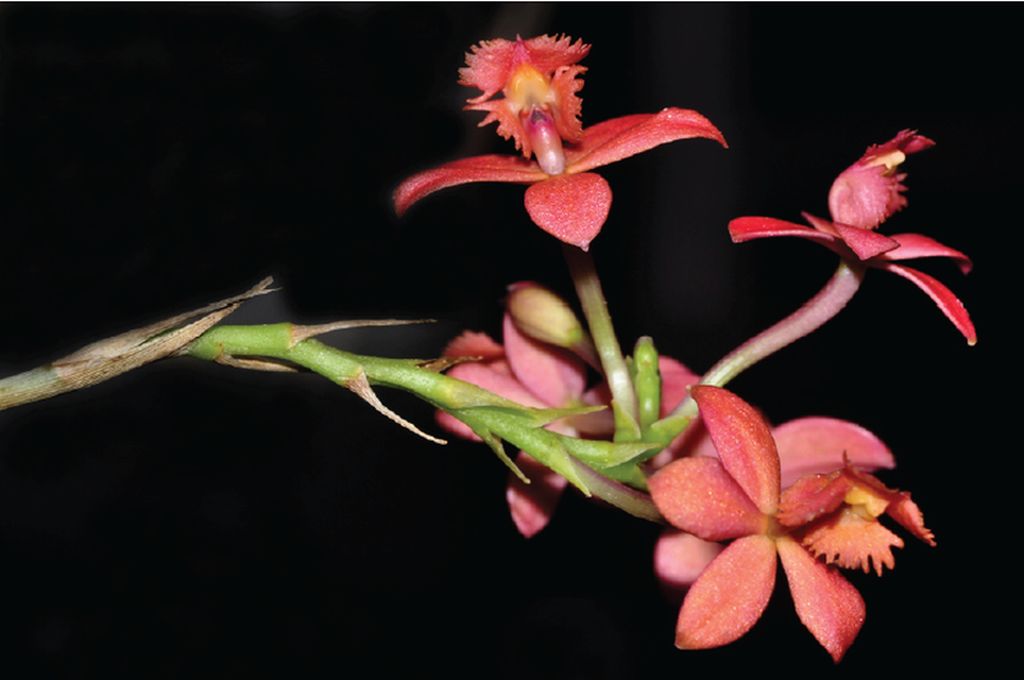

Epidendrum coroicoense Schltr. GROUP Secundum SUBGROUP Elongatum
photo by © Erica Moron de Abad/Drawing by © Jimenez and The AMO Herbaria Website






Common Name The Coroico Epidendrum [a town in the Yungas of Bolivia]
Flower Size .8" [2 cm]
Found in southern Peru and western Bolivia on the Amazon slopes of the Cordillera Oriental at elevations of 1100 to 1600 meters as a large sized, cool growing epiphyte with simple, thin, terete, cane-like, straight stems carrying 5 to 10, alternate, all along the stem, sub-erect, coriaceous, smooth, oblong-elliptic, slightly bilobed apically, marginally entire, leaves that blooms at any time of the year in greenhouse conditions on a terminal, without a spathe, racemose, arching-nutant, producing new racemes in time from the apical nodes of the elongate, 13 to 13.8" [32.5 to 34.5 cm] long, terete, thin, straight, nearly totally enveloped by 7 to 9, acute, tubular sheaths, rachis 2.4 to 2.8" [6.5 to 7 cm] long, terete, thin, successively 4 to 5, 20 to 30 flowered inflorescence with much shorter than the ovary, triangular-lanceolate, acuminate, gradually shorter towards the apex bracts and carrying non-resupinate, laquer red flowers with a dark yellow callus.
"Epidendrum coroicoënse Schltr. belongs to the GROUP Secundum SUBGROUP Elongatum which is recognized by the caespitose habit, simple stems, oblong-lanceolate, coriaceous, bilobed leaves and generally elongate peduncle of the erect inflorescence, pluriracemose, the flowers non-resupinate, the callus complicated, plurituberculate. The species is recognized by the narrow leaves, about 6 to 7 times longer than wide, successive, lacquer-red flowers, the callus dark yellow, sepals about .4" [10 mm] long, the petals wider than the sepals, elliptic-suborbicular, the lip square in outline, 3-lobed, the lateral lobes dolabriform, terminating in a pair of divaricate, narrow, triangular, acute, bifurcate teeth, the lateral lobes overlap with the midlobe when spread, and the mid-lobe flabellate, bilobed and somewhat divaricate; callus 5-tuberculate, 2 basal and 3 apical tubercles, without keels. Epidendrum ibaguense H.B.K. 1816 is very similar, has proportionately wider leaves, about 4 times longer than wide, simultaneous flowers on a solid, thick, erect raceme, the sepals .4 to .44" [10 to 11 mm] long, the petals elliptic-rhomboid, somewhat wider than the sepals, and, the callus is concave at the base, “Y” shaped, and ends in a narrow keel which reaches the apical sinus. Epidendrum tulcanense Hágsater & Dodson from Ecuador has orange-red colored flowers with a massive white callus formed by 9 unequal tubercles on the isthmus of the lip, the lateral lobes of the lip do not overlap the mid-lobe when spread. Epidendrum portokalium Hágsater & Dodson, growing epiphytic at elevations around 800 meters in eastern Ecuador and at higher altitudes as a terrestrial that has orange-red flowers with a yellow callus, formed by 7 tubercles, on the isthmus of the lip. All the preceding species have the apical margins of the lip fimbriate in various degrees." Hagsater etal 2015
"Similar red-flowered species to Epidendrum aromoense are: Epidendrum tulcanense Hágsater & Dodsonhas also red flowers but it is distinguished by the large white massive callus, formed by nine unequal tubercles: four basal ones and the main structure formed by five sub-equal tubercles. Epidendrum laurelense Hágsater & Dodson, that differ from E. aromoense by the carmine-red flowers on a much more open raceme, with a massive white callus formed by a semicircular sulcate, marginally plurilobulate fleshy plate, found between Tulcán and Maldonado, on the border between Ecuador and Colombia, on roadsides and rocks in wet forest at around 2000 to 2500 meters in elevation. Epidendrum coroicoënse Schltr. is another species similar to E. aromoense by the lacquer-red flowers; however, the former species is known from southern Peru and western Bolivia, along the upper Amazon slope of the Cordillera Oriental of the Andes, and differ from E. aromoense by the narrow leaves about 6–7 times longer than wide, the petals wider than the sepals, elliptic-sub-orbicular, the lip bearing lateral lobes overlapping with the mid-lobe when spread; and callus 5-tuberculate with two basal and three apical tubercles, and without keels. Epidendrum portokalium Hágsater & Dodson is another species with red flowers that resembles to Epidendrum aromoense , but it is found on the Amazon slopes of the Andes in central Ecuador, and differs from E. aromoense by the callus unequally 7-tuberculed (with four basal tubercles and three apical ones" Epidendrum aromoense (Orchidaceae, Laeliinae), a New Species from the Coastal Dry Forests in Western Ecuador (PDF Download Available). Available from: Epidendrum aromoense_Orchidaceae Laeliinae a New Species from the Coastal Dry Forests in Western Ecuador [accessed Nov 01 2017].
Synonyms
References W3 Tropicos, Kew Monocot list , IPNI ; *Icones Orchidacearum 15[1] Plate 1516 Hagsater 2015 photo/drawing fide; Icones Orchidacearum 16[1] Plate 1605 Hagsater & Santiago 2018 See recognition section;
--------------------------------------------------------------------------------------------------------------------------
---------------------------------------------------------------------------------------------------------------------------